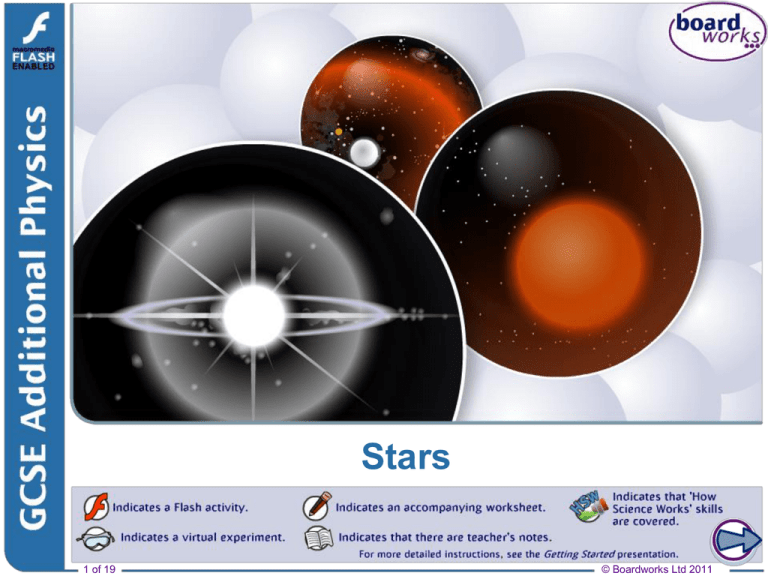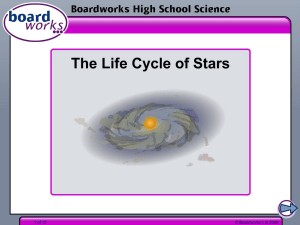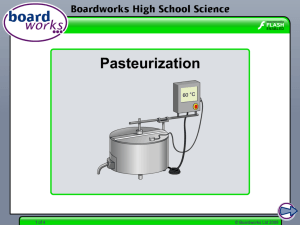Stars
advertisement

Stars 1 of 19 © Boardworks Ltd 2011 2 of 19 © Boardworks Ltd 2011 What powers a star? A star is ‘powered’ by nuclear fusion reactions in its core. Nuclear fusion involves light atomic nuclei joining together to form heavier ones. Each fusion reaction produces a small amount of energy, but there are billions of reactions per second. Each second, the Sun produces 4 × 1026 joules of energy. It would take 2,000 million nuclear power plants a whole year to produce the same amount of energy on Earth. In the Sun, and in most stars, hydrogen atoms fuse together to form helium. This provides the energy for life on Earth. 3 of 19 © Boardworks Ltd 2011 How are elements made? Nuclear fusion in stars produces new atoms. In the early stages of a star’s life, nuclear fusion mainly produces light elements such as helium. When all the hydrogen has been used up, other elements are fused together to make the heavier elements of the periodic table. However, not all elements are made in the early stages of a star’s life. Some of the heavier elements are only made when a star explodes at the end of its life. 4 of 19 © Boardworks Ltd 2011 Heavy elements on Earth 5 of 19 © Boardworks Ltd 2011 6 of 19 © Boardworks Ltd 2011 The life cycle of a star Every star goes through a life cycle. A star’s life cycle is determined by its size. red super giant super nova red giant white dwarf neutron star black hole main sequence star 7 of 19 black dwarf © Boardworks Ltd 2011 How do stars begin and end? 8 of 19 © Boardworks Ltd 2011 Life cycle of small stars 9 of 19 © Boardworks Ltd 2011 What is a supernova? 10 of 19 © Boardworks Ltd 2011 How are black holes formed? The end of the life cycle of really massive stars is different to that of massive stars. After a really massive red giant collapses in a supernova explosion, it leaves an object so dense that nothing, not even light, can escape its gravitational pull. This is called a black hole. Some scientists believe that there are black holes at the centre of galaxies. If light cannot escape from a black hole, then how can a black hole be observed? 11 of 19 © Boardworks Ltd 2011 How can a black hole be ‘seen’? 12 of 19 © Boardworks Ltd 2011 Life cycle of large stars 13 of 19 © Boardworks Ltd 2011 Terms about the life cycle of stars 14 of 19 © Boardworks Ltd 2011 Stars life cycle summary 15 of 19 © Boardworks Ltd 2011 16 of 19 © Boardworks Ltd 2011 Glossary 17 of 19 © Boardworks Ltd 2011 Anagrams 18 of 19 © Boardworks Ltd 2011 Multiple-choice quiz 19 of 19 © Boardworks Ltd 2011




![Direction_and_Scale[1]](http://s2.studylib.net/store/data/005432475_1-80ce3065f13008250a8cdec135db9846-300x300.png)




